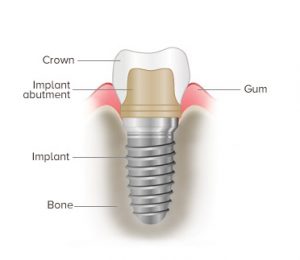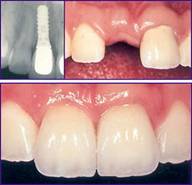Implant Restoration
 Implants are another way to replace missing teeth. An implant is a metal rod embedded into your jawbone and is topped by an implant crown that looks like a natural tooth. When missing teeth are replaced by an implant supported tooth, the overall enhancement to your quality of life is even more significant than with a bridge or a partial/full denture and more permanent. You have no limits on the types of foods you can eat (unlike with bridges or dentures), you eliminate messy denture adhesives and your speech, comfort and appearance are as natural as they can possibly be.
Implants are another way to replace missing teeth. An implant is a metal rod embedded into your jawbone and is topped by an implant crown that looks like a natural tooth. When missing teeth are replaced by an implant supported tooth, the overall enhancement to your quality of life is even more significant than with a bridge or a partial/full denture and more permanent. You have no limits on the types of foods you can eat (unlike with bridges or dentures), you eliminate messy denture adhesives and your speech, comfort and appearance are as natural as they can possibly be.
What is the implant process?
- The first step to an implant process is to determine whether your gums and bone structure are adequate to support the implant rod and tooth. We can refer you to a qualified specialist in implant surgery who will evaluate the benefits of implant placement for you.
- If you are a good candidate for an implant, surgery is performed in the specialist’s office to place the implant rod. During healing the bone grows around the implant to firmly hold it in place.
- Once healing is complete, we place a connector (abutment) on the dental implant and fabricate the implant crown.
What are the advantages of implants?
- An implant is as close to a natural tooth as possible.

- Adjacent teeth are not affected by the implant procedure.
- Implants may decrease or help prevent shrinkage of the jawbone from tooth loss.
- Strategically placed implants can replace multiple teeth.
- Implant teeth are more permanent and natural looking than dentures.
- You care for implant teeth just like your natural teeth – no adhesives or removal is necessary.
